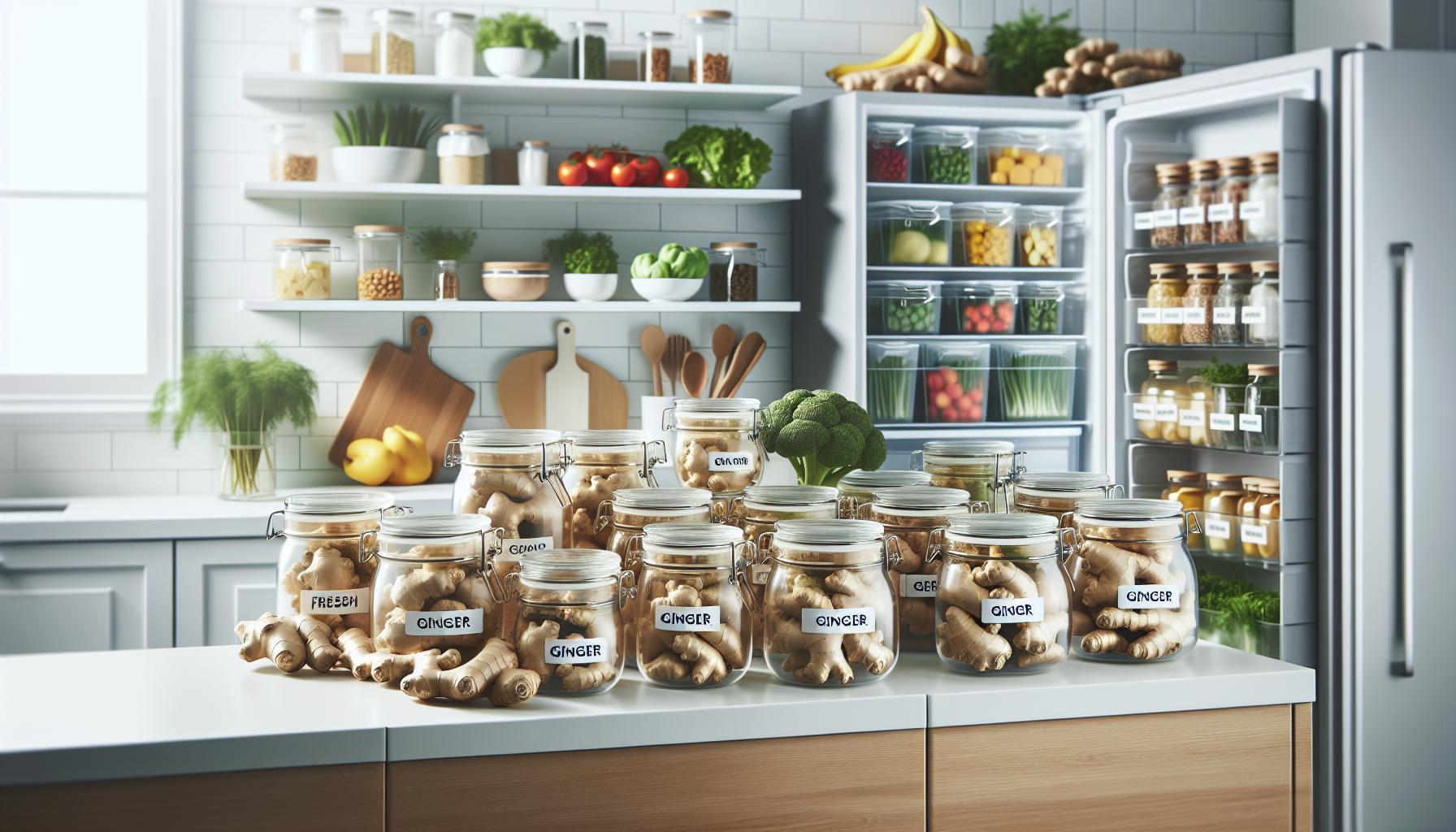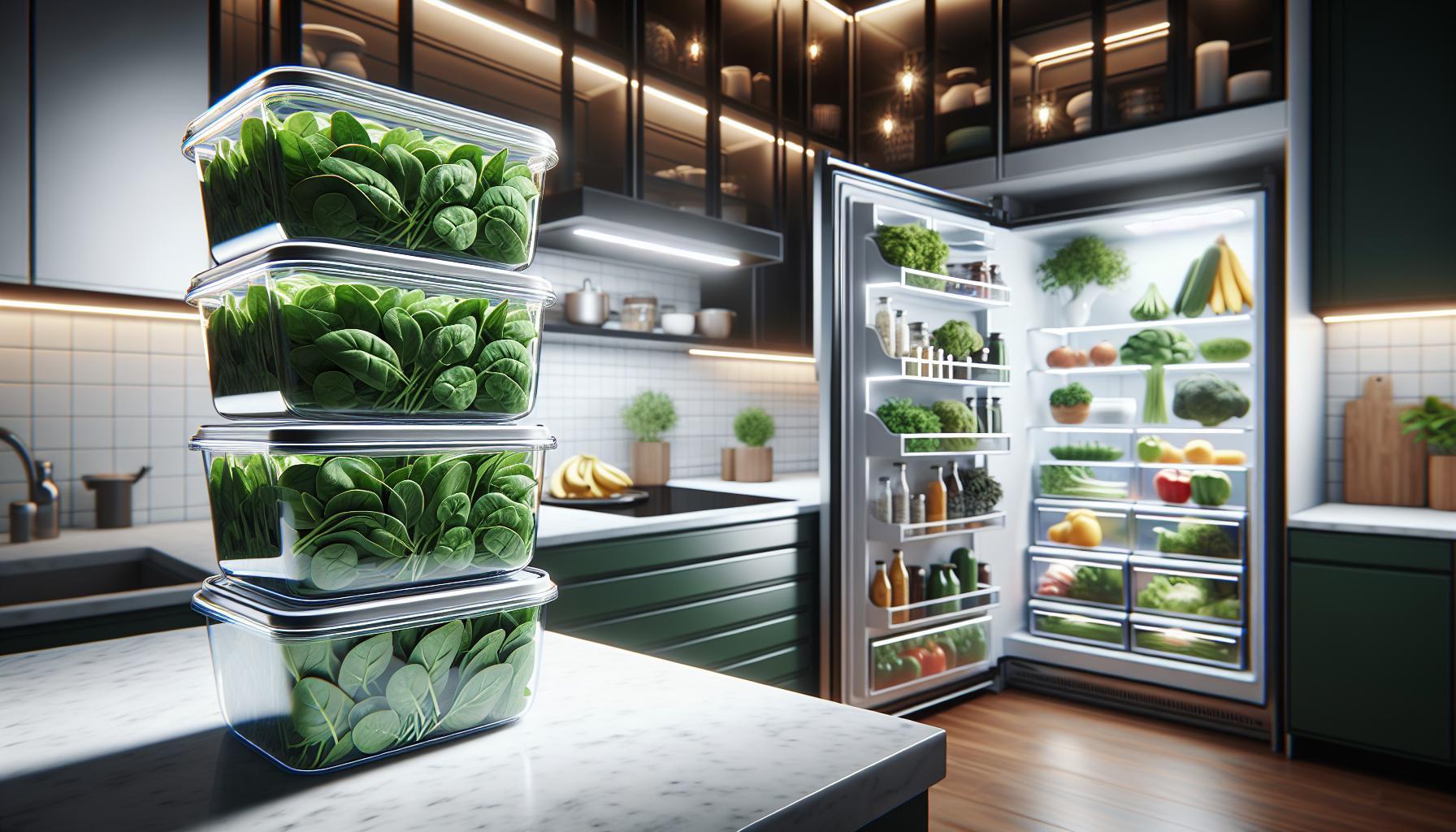Ginger is a beloved ingredient known not only for its unique flavor but also for its impressive health benefits, from aiding digestion to reducing inflammation. However, many home cooks encounter a common dilemma: how long does fresh ginger stay fresh in the fridge? Properly storing ginger is crucial for maintaining its flavor and nutritional value, ensuring you get the most out of this versatile root.
In this guide, we’ll dive into the lifespan of ginger in your refrigerator, share practical freshness hacks, and provide actionable tips for preventing spoilage. Whether you’re a culinary enthusiast or someone looking to incorporate more wholesome ingredients into your diet, understanding how to store ginger effectively is key to maximizing your culinary creations and minimizing waste. Join us as we explore the best practices for keeping your ginger fresh and flavorful!
How Long Can You Keep Ginger in the Fridge?
Keeping ginger fresh in the fridge is key to maximizing its flavor and nutritional benefits. Generally, when stored properly, fresh ginger can last about three weeks in the refrigerator. For optimal freshness, it’s best to leave the skin on, as this helps preserve moisture and prevents spoilage. You can store unpeeled ginger directly in the crisper drawer, ideally in a paper bag or wrapped in a dry paper towel. This setup allows for some air circulation, which is essential to avoid mold growth.
For peeled ginger or any ginger that’s been cut, the storage time decreases. When wrapped tightly in plastic wrap or stored in an airtight container, peeled ginger can maintain its quality for about one week. Always check for signs of moisture condensation inside the container, which can indicate spoilage and lead to faster aging.
If you’re uncertain about the quality of your ginger after a while, there are a few key indicators to assess. Fresh ginger should be firm and smooth; if it feels soft or has developed an off smell, it’s time to discard it. Maintaining a consistent temperature and minimizing exposure to air are crucial in extending ginger’s shelf life, ensuring you have this flavorful spice at hand for your culinary creations.
Understanding Ginger’s Shelf Life

Fresh ginger is a versatile ingredient celebrated not only for its distinct flavor but also for its numerous health benefits. To maintain its culinary and nutritional qualities, understanding how to extend its shelf life while minimizing spoilage is essential. Typically, fresh ginger can be kept for up to three weeks in the refrigerator if properly stored. The key to this longevity lies in maintaining its moisture levels and preventing exposure to air and light, which can accelerate degradation.
To maximize freshness, it’s advisable to store unpeeled ginger directly in the crisper drawer of your fridge, ideally wrapped in a dry paper towel or placed in a paper bag. This method allows for necessary air circulation while protecting the ginger from excess moisture that can lead to mold growth. On the other hand, once ginger is peeled or cut, its shelf life diminishes significantly. When wrapped tightly in plastic or stored in an airtight container, peeled ginger typically lasts for about one week. Consistent checking for condensation in the container is crucial as moisture can hasten spoilage, indicating that it may be time to use or replace the ginger.
Identifying the signs of aging ginger can significantly improve your culinary experience. Fresh ginger should feel firm and smooth; if you notice soft spots or an unpleasant odor, these are telltale signs that it’s time to discard it. By maintaining a consistent temperature and following appropriate storage practices, you’ll ensure that ginger remains a vibrant and healthful addition to your recipes, enriching your meals with its unique taste and health-promoting properties.
Signs Your Ginger Has Spoiled

Determining whether your ginger has spoiled is crucial to ensuring food safety and maintaining the flavors of your dishes. Fresh ginger boasts a strong, spicy aroma and a firm texture. However, as it ages, several telltale signs indicate that it has gone bad.
First and foremost, examine the texture of your ginger. It should feel firm and smooth to the touch. If you notice soft spots or areas where the ginger feels mushy, this often signals that decay has set in. Additionally, check for any visible mold, which can appear as fuzzy patches of white, green, or gray. If mold is present, it’s best to discard the entire ginger piece, as mold can penetrate beyond just the surface.
Another important indicator is the smell. Fresh ginger emits a pungent, spicy scent, while spoiled ginger may develop an unpleasant odor, reminiscent of decay or sourness. If you detect an off-putting smell, it’s safest to dispose of it. Lastly, if the ginger has begun to sprout, although it may still be safe to eat, the flavor can be diminished. While the sprouts themselves are edible, using properly stored ginger ensures you’ll receive the fullest flavor and health benefits.
In summary, maintaining vigilance over the condition of your ginger will help you enjoy its delightful taste and health-enhancing properties. By adhering to these simple checks-texture, smell, and signs of sprouting-you can confidently determine the freshness of your ginger and make informed decisions about its use in your meals.
Best Storage Practices for Fresh Ginger
To ensure that fresh ginger retains its flavor and nutritional benefits for as long as possible, proper storage is crucial. When properly stored in the fridge, fresh ginger can last several weeks, allowing you to make the most of its vibrant taste and health benefits. Here are key practices to keep your ginger fresh and flavorful.
To start, store your ginger in the vegetable crisper drawer of your refrigerator, where the humidity levels are higher and temperature more stable. Wrap the ginger in a paper towel to absorb excess moisture, as extended dampness can promote mold growth. After wrapping, place the ginger in a breathable container, like a perforated plastic bag or a cloth bag, to allow for air circulation while preventing moisture buildup. As an alternative, you can store ginger in a sealed container with a few holes poked to ensure ventilation.
If you find yourself using ginger more frequently, consider peeling and slicing the root before storage. You can place the sliced ginger in an airtight container or a jar submerged in sherry or vinegar, which can help extend its shelf life while also infusing your cooking with additional flavor. Always label your containers with the date to keep track of freshness. Ultimately, aim to use fresh ginger within two to three weeks for the best taste and health benefits.
For longer storage, ginger can be frozen. Simply peel and chop or grate the ginger, then place it in an airtight freezer bag or container. Frozen ginger will remain usable for up to six months and can be directly added to dishes without thawing. This method not only preserves your ginger but also provides convenient portions for cooking.
Freezing Ginger: Step-by-Step Guide
Freezing ginger is an excellent way to preserve its robust flavor and health benefits while extending its shelf life significantly. When frozen properly, ginger can last up to six months without losing its quality. This method allows you to conveniently access ginger whenever needed, whether for a warming tea, a zesty stir-fry, or even a baked good.
To begin, select fresh ginger root that is firm and free from blemishes. Start with these straightforward steps:
Step-by-Step Freezing Guide
- Preparation: Peel the ginger using a spoon or a vegetable peeler to remove the skin. This makes the ginger easier to chop or grate.
- Chop or Grate: Depending on your intended use, you can either chop the ginger into small pieces or grate it. Grating creates smaller portions that are great for recipes requiring less ginger.
- Portion Control: Divide the ginger into portions that you typically use in your recipes. This step minimizes the need to thaw the entire batch every time you want to cook.
- Freezing: Place the ginger portions in an airtight freezer bag or container. Ensure to remove as much air as possible to prevent freezer burn. If using a freezer bag, squeeze out excess air before sealing.
- Labeling: Don’t forget to label each bag or container with the date you froze the ginger. This practice will help you track freshness and usage.
Once frozen, ginger can be taken directly from the freezer and added to your recipes without thawing. This not only makes meal preparation quicker but also ensures that you consistently have fresh ginger on hand. Remember that while frozen ginger may not have the exact texture of fresh ginger when thawed, it remains very flavorful and retains its nutritional benefits, making it a smart choice for meal prep.
The Impact of Different Ginger Varieties on Freshness
The freshness and shelf life of ginger can vary significantly depending on the variety of ginger you choose. While the most common type, Zingiber officinale, is widely known for its culinary uses and health benefits, there are several other varieties, each with distinct characteristics that can influence how long they stay fresh.
For example, young or “wet” ginger, often found in Asian markets, differs from mature ginger. Young ginger features a thinner skin and a juicy, tender texture, making it less pungent. While it is delightful in cooking, it tends to spoil faster if not stored correctly. It’s best used within a week or two when kept in the refrigerator. In contrast, mature ginger, with its tougher skin, can last much longer-up to three weeks in the fridge-if stored properly.
When considering different storage methods, the impact of ginger variety on freshness becomes more evident. While all types of ginger should ideally be kept in a cool, dark place, dry conditions can particularly enhance the longevity of mature ginger. For those looking to extend the shelf life of fresh ginger, freezing is a highly effective option, regardless of the variety. Remember, regardless of the type, always check for firm textures and avoid any signs of decay, especially when dealing with young ginger.
Understanding these differences not only helps in choosing the right ginger variety for your cooking needs but also ensures you can maximize freshness, reducing waste and enhancing flavor in your dishes. Whether you prefer the zest of young ginger or the robust aroma of mature ginger, proper storage techniques based on the specific variety can make all the difference.
Preserving Ginger: Essential Techniques
To keep ginger in peak condition and prolong its freshness, several effective storage techniques can be employed. Proper preservation not only enhances the longevity of ginger but also maintains its delightful flavor and medicinal properties. One of the most critical aspects of preserving ginger is to ensure that it is stored in an environment that limits exposure to moisture and air, both of which can accelerate spoilage.
Best Practices for Storing Fresh Ginger
- Refrigeration: For short-term storage, keep fresh ginger in the refrigerator. Place the root unpeeled in a paper towel and then put it in a resealable plastic bag. This will help absorb any excess moisture, preventing mold growth and keeping the ginger fresh for about 2 to 3 weeks.
- Freezing: Freezing is an excellent method to extend the shelf life of ginger. You can freeze whole ginger roots by simply wrapping them in plastic wrap and then placing them in a freezer bag. Alternatively, you can slice or grate the ginger and freeze it in an ice cube tray with water or oil. This allows for easy portioning when you need to use it later.
- Drying: An underrated technique is drying. Slice ginger into thin pieces and use a dehydrator or your oven on a low setting to thoroughly dry out the pieces. Once dried, store them in an airtight container in a cool, dark place. Dried ginger can last for several months and is great for cooking and teas.
Preserving Ginger Paste and Other Preparations
Another effective way to preserve ginger is by making ginger paste. To prepare ginger paste, blend fresh ginger with a bit of oil and store it in an airtight container in the refrigerator. This paste typically lasts about 1 to 2 weeks. For longer preservation, store the ginger paste in ice cube trays, freeze until solid, and then transfer the cubes to a freezer bag. This allows for convenient use in your dishes while maintaining flavor freshness.
By employing these simple yet effective techniques, you’ll ensure that your ginger remains flavorful and usable far beyond its typical shelf life. Whether using it fresh, dried, or in paste form, proper storage practices are key to enjoying its unique taste and health benefits throughout the year.
Ginger Paste vs. Fresh Root: Storage Differences
When considering the best way to use ginger in your cooking, understanding the storage differences between fresh ginger root and ginger paste is essential for maintaining flavor and extending shelf life. Fresh ginger, known for its firm texture and vibrant aroma, can typically last about 2 to 3 weeks in the refrigerator when stored correctly. Keep it unpeeled in a paper towel inside a resealable plastic bag to minimize moisture exposure, which helps prevent spoilage. On the other hand, ginger paste, made by blending fresh ginger with a bit of oil, offers a convenient alternative. This paste can be stored in an airtight container in the fridge for about 1 to 2 weeks.
For those looking to prolong their ginger’s usability, freezing is a game changer. While fresh ginger can be frozen whole, sliced, or grated, ginger paste also freezes well. To freeze ginger paste, pour it into ice cube trays, freeze until solid, and transfer the cubes to a freezer bag. This method allows for easy portion control and makes it simple to add that ginger kick to your recipes at a moment’s notice. When thawed, the flavor remains potent, making both fresh ginger and ginger paste viable options for flavoring your dishes, but frozen ginger paste provides the advantage of convenience.
It’s crucial to be aware of how to recognize spoilage in both forms. Fresh ginger may develop mold, turn soft, or even sprout-these are the clear signs it’s no longer good to use. Conversely, ginger paste that shows any signs of mold or an off smell should be discarded. By making informed choices about storage and usage, you can enjoy the distinctive taste and health benefits of ginger without waste, maximizing its potential in your culinary adventures.
Storing Dried Ginger: What You Need to Know
Dried ginger is a pantry staple packed with flavor and health benefits, often used in cooking, baking, and herbal teas. One of the best aspects of dried ginger is its long shelf life, making it a convenient option for those who may not always have fresh ginger on hand. When stored properly, dried ginger can last up to three years, allowing you to enjoy its unique taste and medicinal properties without the concern of spoiling quickly.
To ensure your dried ginger maintains its quality, it’s crucial to store it in a cool, dry place away from direct sunlight. An airtight container, such as a glass jar or a vacuum-sealed bag, is ideal. This protects the ginger from moisture and air, both of which can lead to degradation of flavor and aroma. It’s also wise to keep dried ginger away from heat sources, as excessive heat can compromise its volatile oils and flavor.
Signs of Spoilage
While dried ginger has an impressive shelf life, it can lose potency over time. Be attentive to changes in color, aroma, and flavor. If the dried ginger has a faded color or a weak, musty smell, it’s best to replace it. Additionally, if you find any signs of mold or pests in the container, dispose of it immediately. To ensure maximum freshness, consider labeling your storage container with the purchase date, so you can keep track of its age effectively.
Maximizing Longevity
Taking a few extra measures can greatly extend the shelf life of your dried ginger. To enhance preservation, consider using moisture absorbers, like silica gel packs, in the storage container. Remember to avoid storing dried ginger in places with high humidity, like above the stove or in a kitchen cabinet near the sink. Instead, opt for storage in a pantry or cupboard that remains consistently dry and well-ventilated.
By following these storage tips, you can keep your dried ginger flavorful and ready for use in your favorite recipes for an extended period, ensuring that its delightful taste and health benefits are always at your disposal.
Common Mistakes When Storing Ginger
When it comes to storing ginger, many people unknowingly make several common mistakes that can compromise its freshness and flavor. One of the most significant errors is storing ginger in a plastic bag or container that doesn’t allow for proper airflow. Ginger thrives in environments that are cool and dry, and sealing it up tightly can trap moisture, leading to mold growth and spoilage. Instead, opt for a breathable material like a paper bag or wrap it loosely in a kitchen towel before placing it in the fridge to maintain adequate ventilation.
Another mistake is failing to clean ginger properly before storage. It’s easy to assume that just because ginger is a tough root, it doesn’t need care. However, any dirt or moisture left on the surface can promote mold growth. Always wipe the ginger root with a dry cloth before storing, and avoid washing it until you’re ready to use it. This simple step can significantly prolong its shelf life.
Additionally, many people overlook the importance of temperature stability. Storing ginger in the fridge’s crisper drawer may seem like a good idea, but temperature fluctuations-like frequent door openings-can affect its longevity. Instead, find a spot in the fridge that maintains a consistent cool temperature. For longer-term storage options, freezing ginger is clever and effective, but remember to peel and chop or grate it beforehand to make it easier to use later.
Lastly, keeping ginger in close proximity to other ethylene-producing fruits, such as apples and bananas, is a mistake. Ethylene gas can hasten the ripening and decay of ginger. To avoid this, place ginger away from these fruits, ideally in its own dedicated space in the fridge. By addressing these common pitfalls, you can ensure that your ginger remains fresh and flavorful for a longer time, ready to enhance your culinary creations.
Using Ginger Beyond Its Shelf Life: Safety Tips
Using ginger beyond its recommended shelf life can seem risky, yet there are safe ways to extend its usability and mitigate waste. While fresh ginger stored in the fridge typically lasts 1 to 3 weeks, proper observation and handling can allow you to utilize ginger that’s past this timeframe while ensuring safety. Always begin by inspecting the ginger carefully. If it shows slight wrinkling or firmness, it’s likely still usable; however, if there’s excessive softness, mold, or an off-putting odor, it’s best to discard it.
For ginger that appears mostly intact but is close to its prime, consider these safety tips:
- Trim and Peel: If you find some soft spots, simply cut them away. Ensure the remaining flesh is firm and free of any mold before using.
- Cook Thoroughly: Incorporate ginger into recipes where thorough cooking is possible, such as soups or stir-fries. The heat can kill any potential bacteria, making it safer to consume.
- Flavor Infusion: Use older ginger to create infused oils or flavored syrups. The cooking process not only enhances its flavor but sanitizes it.
Managing ginger’s freshness also involves understanding how to repurpose it. For instance, if you’re nearing the end of your ginger but it’s still decent, consider making a ginger tea. Simply simmer sliced ginger in water; this method allows you to enjoy its health benefits while bypassing concerns about spoilage.
Ultimately, while ginger can be versatile and forgiving, prioritizing safety is critical. Following these guidelines will help you make the most of your kitchen staples while minimizing waste. Stay vigilant, and when in doubt, trust your senses. If ginger doesn’t smell or look right, it’s best to part ways-after all, safety in the kitchen should never be compromised.
Innovative Ways to Use Leftover Ginger
Ginger, with its unique flavor and numerous health benefits, can easily become a staple in your kitchen. But what do you do when you find yourself with leftover ginger that’s nearing its expiry? Instead of discarding it, there are numerous innovative ways to utilize those bits of ginger, ensuring you make the most out of this versatile root while reducing waste.
One effective approach is to create homemade ginger tea. Simply slice up your leftover ginger, simmer it in water, and let it steep. This nourishing beverage not only helps warm you up but also offers anti-inflammatory and digestive benefits. You can sweeten it with honey or add a splash of lemon for an extra boost. This method allows you to enjoy the health benefits while effectively using up your ginger.
Another creative option is to incorporate ginger into your baking. Grate or finely chop ginger and add it to recipes for muffins, cookies, or cakes. The warm, spiced flavor complements many desserts and can elevate your usual recipes. Additionally, you can make a ginger-infused syrup by boiling ginger with sugar and water. This syrup can be drizzled over pancakes, added to cocktails, or used to flavor your favorite desserts.
You can also consider making a aromatic ginger oil. Heat a neutral oil, such as grapeseed or olive oil, and add chopped ginger. Allow it to infuse at a low temperature for about 30 minutes, then strain out the solids. This oil can be used for cooking or as a salad dressing, imparting a vibrant ginger flavor to your dishes.
Finally, if you’re feeling adventurous, you can pickle leftover ginger. Thinly slice the ginger and immerse it in a mixture of vinegar, sugar, and salt. Let it marinate for at least a day in the fridge. This creates a tangy accompaniment that pairs wonderfully with sushi or can be enjoyed on its own as a zesty snack.
By employing these innovative ideas, you not only extend the life of your ginger but also enhance your culinary experiences. Always ensure that the ginger is still safe to consume, and embrace the creativity that comes with using leftover ingredients.
Q&A
Q: How can you tell if ginger is still good?
A: To determine if ginger is still good, check for firmness and vibrant skin. If it feels soft, has dark spots, or shows signs of mold, it’s best to discard it. Fresh ginger should have a spicy aroma. Refer to the section on “Signs Your Ginger Has Spoiled” for more details.
Q: Can you use dried ginger instead of fresh?
A: Yes, you can use dried ginger instead of fresh, but the flavor and potency will differ. Dried ginger is more concentrated, so use about one-quarter the amount of fresh ginger in recipes. For best results in cooking, learn more in the section on “Storing Dried Ginger.”
Q: What is the best way to store ginger in the fridge?
A: Store fresh ginger in a paper bag or wrap it in a paper towel and place it in a ventilated container in the fridge. This helps maintain moisture while preventing mold. For additional tips, see “Best Storage Practices for Fresh Ginger.”
Q: How long can you keep peeled ginger in the fridge?
A: Peeled ginger can last in the fridge for up to one week when properly stored in an airtight container. If you need longer storage, consider freezing it. More information can be found in the “Freezing Ginger: Step-by-Step Guide” section.
Q: Can ginger go bad in the fridge?
A: Yes, ginger can go bad in the fridge. It can spoil if exposed to moisture or air for too long, leading to mold or a mushy texture. Always check for signs of spoilage before use. For cleanliness tips, refer to “Common Mistakes When Storing Ginger.”
Q: Is it safe to eat old ginger?
A: Eating old ginger is not recommended if it shows signs of spoilage, such as mold or an off smell. However, ginger that is slightly dried out but still firm may be safe to use. Always assess the condition first. For tips on using ginger beyond its shelf life, see “Using Ginger Beyond Its Shelf Life: Safety Tips.”
Q: How does freezing affect ginger’s texture?
A: Freezing ginger can change its texture, making it softer once thawed. However, this does not affect the flavor. To freeze effectively, peel and slice it before storing in airtight bags. More details are available in “Freezing Ginger: Step-by-Step Guide.”
Q: What are some creative ways to use leftover ginger?
A: Leftover ginger can be used in smoothies, teas, stir-fries, or even as a flavor enhancer in soups and marinades. Shredding or grating the leftover ginger can incorporate it easily into various dishes. Explore innovative uses in the section “Innovative Ways to Use Leftover Ginger.”
The Conclusion
By following the storage tips shared in “How Long Does Ginger Last in the Fridge? Freshness Hacks Revealed,” you can ensure your ginger stays fresh and flavorful for as long as possible, enhancing your culinary creations. Remember, storing ginger properly not only extends its shelf life but also preserves its nutritional benefits. If you’re curious about other kitchen staples, check out our guides on how to store garlic effectively and maximize the freshness of herbs.
For those looking to deepen their knowledge, consider subscribing to our newsletter for more expert food storage tips delivered straight to your inbox. Don’t hesitate to leave a comment below with your own ginger hacks or questions-we love hearing from you! Let’s keep the conversation going and explore more ways to utilize this fantastic ingredient for your health and cooking delights. Your kitchen deserves the best, and we’re here to help you achieve it!





